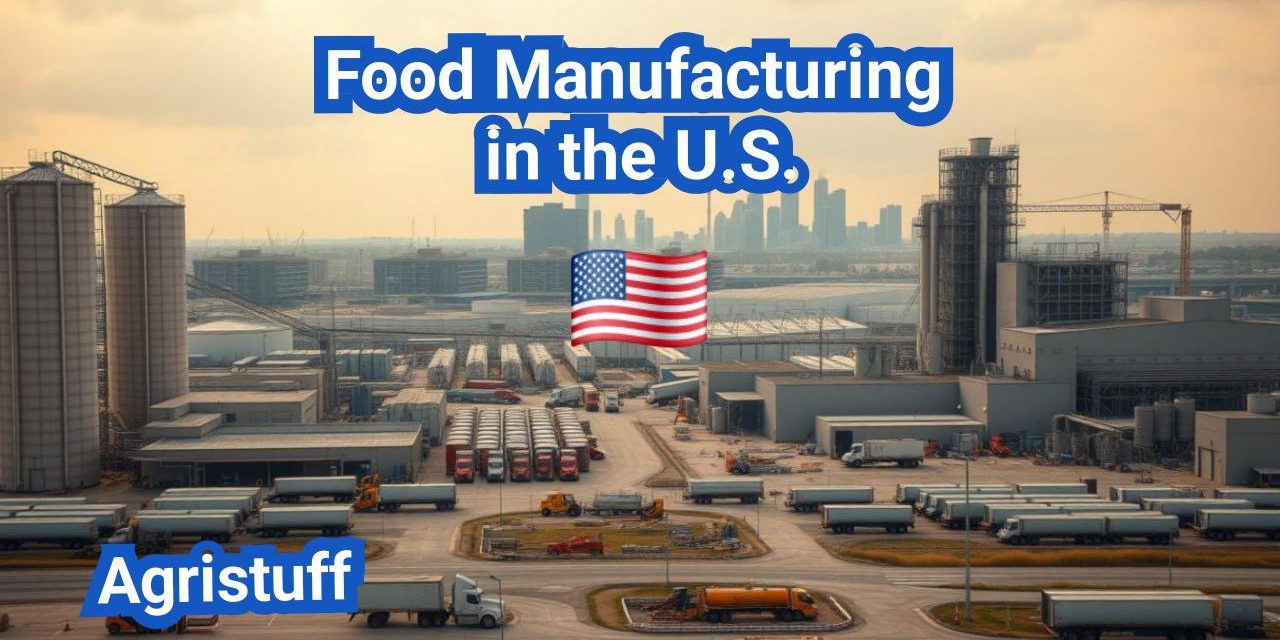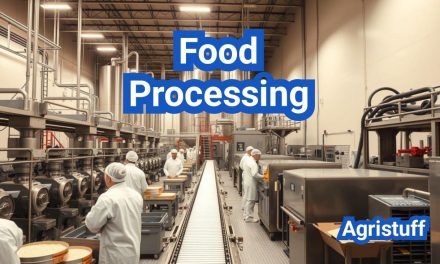The U.S. food processing industry is a vital component of the country’s economy, transforming raw agricultural products into consumable goods. This complex process involves various stages, from preparation to packaging, ensuring the final products are safe and ready for consumption.
Food manufacturing encompasses a wide range of activities, including processing, preserving, and packaging food products. The industry produces a diverse array of goods, from baked goods and beverages to meat and dairy products.
Key Takeaways
- The U.S. food processing industry plays a crucial role in the national economy.
- Food manufacturing involves transforming raw agricultural products into consumable goods.
- The industry produces a wide variety of products, including baked goods, beverages, and dairy products.
- Food production processes include processing, preserving, and packaging.
- The industry is subject to various regulations to ensure product safety.
The Evolution of Food Manufacturing in America
The history of food manufacturing in the U.S. is a story of continuous innovation and adaptation. From its early beginnings to the present day, the industry has undergone significant transformations driven by technological advancements, changing consumer demands, and evolving regulatory landscapes.
Historical Development of Industrial Food Production
The development of industrial food production in America began in the late 19th century, marked by the introduction of new manufacturing technologies and processes. The construction of the transcontinental railroad in 1869 revolutionized the transportation of raw materials and finished goods, enabling the growth of large-scale food manufacturing operations. Key innovations included the development of canning technology, which allowed for the preservation of food on a large scale, and the introduction of mechanical refrigeration, which improved the storage and transportation of perishable goods.
As the industry evolved, food manufacturers began to adopt more sophisticated production techniques, including the use of assembly-line production and the introduction of new ingredients and processing aids. The early 20th century saw the rise of large food processing companies, such as Kraft and General Foods, which would later become industry leaders.
Key Milestones in U.S. Food Manufacturing History
Several key milestones have shaped the U.S. food manufacturing industry into what it is today. Some of the most significant include:
- The introduction of pasteurization in the early 20th century, which greatly improved food safety.
- The development of frozen food technology in the mid-20th century, which expanded the range of products that could be manufactured and distributed.
- The introduction of Hazard Analysis and Critical Control Points (HACCP) in the 1960s, which marked a significant shift towards preventive food safety controls.
- The implementation of the Food Safety Modernization Act (FSMA) in 2011, which further strengthened food safety regulations and enforcement.
These milestones, among others, have contributed to the evolution of the U.S. food manufacturing industry, enabling it to become one of the most sophisticated and safe in the world.
Understanding Food Manufacturing: Core Processes and Definitions

At its core, food manufacturing encompasses a range of activities, from cleaning and processing to packaging and distribution. This multifaceted process transforms raw ingredients into consumable products, playing a vital role in the U.S. food system.
What Constitutes Food Manufacturing
Food manufacturing involves various processes that ensure the production of safe and quality food products. The process begins with the sourcing of raw materials, followed by cleaning, processing, and packaging. Processing is a critical step that can involve techniques such as cooking, canning, or freezing to extend shelf life and enhance product safety.
The food production process is complex and requires careful planning and execution. As noted by industry experts, “The key to successful food manufacturing lies in maintaining a clean and controlled environment throughout the production process.”
“The food industry is highly regulated, and manufacturers must adhere to strict guidelines to ensure product safety and quality.”
NAICS311: The Official Classification System
The North American Industry Classification System (NAICS) code 311 is used to classify food manufacturing establishments. NAICS311 encompasses a broad range of industries involved in food processing, including grain and oilseed milling, sugar and confectionery manufacturing, and fruit and vegetable preserving.
| NAICS Code | Industry Description |
|---|---|
| 311111 | Dog and Cat Food Manufacturing |
| 311211 | Flour Milling |
| 311311 | Sugarcane Mills |
| 311411 | Frozen Fruit, Juice, and Vegetable Manufacturing |
The NAICS classification system is crucial for statistical and regulatory purposes, providing a standardized framework for categorizing food manufacturing activities.
Understanding the core processes and definitions in food manufacturing is essential for appreciating the complexity of the industry. By examining the various stages involved in food production, from raw material sourcing to final product packaging, we can gain insights into the challenges and opportunities facing food manufacturers.
The Structure of the U.S. Food Manufacturing Industry
The structure of the U.S. food manufacturing industry is characterized by various sectors, leading companies, and a wide geographical distribution of manufacturing facilities. This diversity contributes to the complexity and resilience of the industry.
Major Sectors and Product Categories
The U.S. food manufacturing industry encompasses several major sectors, including:
- Meat and poultry processing: This sector involves the slaughtering, processing, and packaging of meat and poultry products.
- Dairy product manufacturing: Companies in this sector produce a range of dairy products, from milk and cheese to yogurt and ice cream.
- Fruit and vegetable processing: This includes canning, freezing, and dehydrating fruits and vegetables.
- Grain and oilseed milling: This sector is involved in the processing of grains and oilseeds into flour, oils, and other products.
- Bakery and tortilla manufacturing: Companies here produce bread, cakes, cookies, and tortillas.
These sectors produce a wide array of products that are consumed domestically and exported internationally.
Leading Companies and Market Share Analysis
The U.S. food manufacturing industry is dominated by several leading companies across different sectors. For instance:
- In meat processing, companies like Tyson Foods and JBS USA have significant market shares.
- In dairy, Nestle USA and Danone North America are major players.
- For grain and oilseed milling, Archer Daniels Midland and Cargill are key companies.
Market share analysis reveals that these large companies often have a substantial impact on the industry’s overall performance and trends.
Regional Distribution of Manufacturing Facilities
The distribution of food manufacturing facilities across the U.S. is influenced by factors such as raw material availability, transportation infrastructure, and labor costs. Key regions for food manufacturing include:
- The Midwest, known for its agricultural production and often referred to as the “breadbasket” of the country.
- The West Coast, particularly California, which is a major hub for fruit and vegetable processing.
- The Southeast, where poultry processing is significant.
This regional distribution supports the industry’s efficiency and ability to supply a wide range of products to consumers nationwide.
From Farm to Factory: The Food Production Process

The food production process is a critical component of the food manufacturing industry, involving raw material sourcing, primary processing, and secondary processing. This complex process transforms raw agricultural materials into finished food products that are safe for consumption and meet consumer expectations.
Raw Material Sourcing and Agricultural Connections
Raw material sourcing is the initial step in the food production process. It involves procuring raw agricultural materials from farms, ranches, and other suppliers. The quality and consistency of these raw materials are crucial for producing high-quality food products. Food manufacturers often establish close relationships with farmers and agricultural suppliers to ensure a stable supply of raw materials that meet their specifications.
Agricultural connections play a vital role in the food production process. Many food manufacturers are now adopting sustainable agricultural practices to reduce their environmental footprint and improve the quality of their raw materials. This includes practices such as crop rotation, organic farming, and precision agriculture.
Primary Processing Operations
Primary processing involves the initial transformation of raw agricultural materials into a more refined state. This can include operations such as cleaning, sorting, grinding, and cutting. The goal of primary processing is to prepare the raw materials for further processing or to create a basic product that can be used as an ingredient in other food products.
Examples of primary processing operations include:
- Meat slaughtering and processing
- Grain milling
- Fruit and vegetable processing
| Primary Processing Operation | Description | Example Products |
|---|---|---|
| Meat Slaughtering | Involves the slaughtering and initial processing of animals for meat production. | Beef carcasses, pork bellies |
| Grain Milling | Involves grinding grains into flour or other milled products. | Wheat flour, cornmeal |
| Fruit and Vegetable Processing | Involves cleaning, sorting, and packaging fruits and vegetables for consumption or further processing. | Canned vegetables, frozen fruits |
Secondary Processing and Value Addition
Secondary processing involves further transforming the products from primary processing into more complex food products. This can include operations such as mixing, cooking, baking, and packaging. The goal of secondary processing is to add value to the products by enhancing their flavor, texture, and convenience.
Examples of secondary processing operations include:
- Baking bread and pastries
- Manufacturing ready-to-eat meals
- Producing snack foods
The combination of primary and secondary processing operations enables food manufacturers to create a wide range of products that cater to diverse consumer preferences and dietary needs.
Regulatory Framework Governing Food Manufacturing
The U.S. food manufacturing sector operates under a stringent regulatory environment, overseen by key agencies such as the FDA and USDA. This complex framework is designed to ensure the safety and quality of food products, protecting consumers and maintaining public health.
FDA and USDA Oversight Responsibilities
The FDA and USDA play critical roles in regulating food manufacturing. The FDA is responsible for ensuring the safety of most food products, including processed foods, dairy, and seafood. The USDA, on the other hand, oversees the safety of meat, poultry, and egg products. “Collaboration between these agencies is essential to maintaining a cohesive and effective food safety system,” as stated by industry experts.
The division of responsibilities between the FDA and USDA is crucial for comprehensive coverage of the food supply. For instance, the FDA regulates food additives and labeling, while the USDA ensures compliance with meat and poultry inspection regulations.
FSMA Preventive Controls Requirements
The Food Safety Modernization Act (FSMA) has significantly impacted food manufacturing regulations. The Preventive Controls rule under FSMA requires manufacturers to implement preventive controls to minimize or prevent hazards in food production. This proactive approach to food safety involves identifying potential contamination risks and implementing controls to mitigate these risks.
Manufacturers must develop and implement a food safety plan that includes:
- Identifying potential hazards
- Implementing preventive controls
- Monitoring and verifying the effectiveness of these controls
- Maintaining records of these activities
As emphasized by the FDA, “Preventive controls are a critical component of a robust food safety system.”
Food Traceability Rule (FSMA 204) Implementation
The Food Traceability Rule, also known as FSMA 204, aims to enhance the ability to trace food products throughout the supply chain. This rule requires food manufacturers to maintain detailed records of their food production and distribution, enabling more efficient tracking in the event of a food safety issue.
Key components of the Food Traceability Rule include:
- Maintaining records of Critical Tracking Events (CTEs)
- Keeping records of Key Data Elements (KDEs)
- Providing traceability information to regulatory agencies upon request
Effective implementation of the Food Traceability Rule is crucial for quickly identifying and containing food safety issues, thereby protecting consumers and reducing the economic impact of foodborne outbreaks.
Compliance with these regulations is not only a legal requirement but also a critical component of maintaining consumer trust and ensuring the long-term sustainability of food manufacturing operations.
Food Safety Systems in Manufacturing Facilities

Food safety systems are critical components of manufacturing facilities, safeguarding public health. These systems encompass various protocols and procedures designed to prevent contamination and ensure the production of safe food products.
HACCP Implementation in Meat and Poultry Plants
Hazard Analysis and Critical Control Points (HACCP) is a systematic approach to identifying and controlling hazards in the food production process. In meat and poultry plants, HACCP implementation is crucial for preventing biological, chemical, and physical hazards.
Key steps in HACCP implementation include:
- Conducting a hazard analysis to identify potential risks
- Determining critical control points (CCPs) where hazards can be controlled
- Establishing critical limits for each CCP
- Implementing monitoring procedures to ensure CCPs are within critical limits
- Corrective actions are taken when a CCP is not within its critical limits
Sanitation and Environmental Monitoring Programs
Sanitation and environmental monitoring are vital components of food safety systems. These programs help prevent the introduction of pathogens into the production environment.
Effective sanitation practices include:
- Regular cleaning and sanitizing of equipment and surfaces
- Implementing a master sanitation schedule
- Training personnel on proper sanitation techniques
Environmental monitoring involves testing the production environment for pathogens and indicators of contamination. This helps identify potential issues before they become major problems.
| Monitoring Parameter | Frequency | Acceptable Limit |
|---|---|---|
| Listeria spp. | Weekly | Absent |
| Salmonella | Monthly | Absent |
| Enterobacteriaceae (EB) | Daily | <10 CFU |
Food Defense and Intentional Adulteration Prevention
Food defense involves protecting the food supply from intentional contamination or adulteration. Manufacturing facilities must implement measures to prevent acts of terrorism or other malicious acts that could compromise food safety.
Key elements of a food defense plan include:
- Conducting a vulnerability assessment to identify potential threats
- Implementing controls to mitigate identified vulnerabilities
- Training personnel on food defense protocols
- Regularly reviewing and updating the food defense plan
By implementing robust food safety systems, including HACCP, sanitation and environmental monitoring, and food defense measures, manufacturing facilities can ensure the production of safe and wholesome food products.
Packaging and Labeling in Food Manufacturing

Packaging and labeling play a pivotal role in food manufacturing, impacting product safety, consumer trust, and compliance with federal regulations. The complexity of these elements necessitates a comprehensive understanding of the various requirements and standards that govern the industry.
Packaging Materials and Food Contact Substances
The selection of appropriate packaging materials is critical in ensuring the safety and quality of food products. Food contact substances must comply with FDA regulations to prevent contamination and ensure consumer safety. Manufacturers must consider factors such as durability, barrier properties, and compatibility with the packaged product.
- Types of packaging materials: glass, plastic, metal, and paper
- Regulations governing food contact substances
- Innovations in sustainable packaging
Nutrition Facts Label Requirements
Accurate Nutrition Facts labeling is essential for consumer information and compliance with FDA regulations. The label must include details such as serving size, calories, and percentages of daily values for various nutrients. Updates to the Nutrition Facts label have included changes to serving sizes and the addition of new nutrients.
- Required components of the Nutrition Facts label
- Updates and changes to labeling requirements
- Compliance deadlines for manufacturers
Food Allergen Labeling and the FASTER Act
Food allergen labeling is a critical aspect of consumer safety, particularly for individuals with life-threatening allergies. The FASTER Act (Food Allergy Safety, Treatment, Education, and Research Act) has introduced new requirements for the labeling of certain allergens. Manufacturers must ensure compliance with these regulations to protect consumers and avoid legal repercussions.
- Major food allergens requiring labeling
- Provisions of the FASTER Act
- Impact on food manufacturers and consumers
Bioengineered Food Disclosure Standard (USDA BE)
The Bioengineered Food Disclosure Standard set by the USDA requires the labeling of bioengineered foods. This regulation aims to provide consumers with information about the presence of genetically engineered organisms in their food. Manufacturers must adhere to specific guidelines for labeling and disclosure.
| Category | Description | Labeling Requirement |
|---|---|---|
| Bioengineered Foods | Foods containing genetically engineered organisms | Mandatory disclosure on labeling |
| Non-Bioengineered Foods | Foods without genetically engineered organisms | Voluntary disclosure allowed |
Technology and Innovation in Food Manufacturing

The food manufacturing industry is on the cusp of a technological revolution, driven by innovations in smart manufacturing, automation, and data analytics. This transformation is enhancing operational efficiency, improving product quality, and reducing costs.
Smart Manufacturing Implementation
Smart manufacturing involves the integration of advanced technologies, such as the Internet of Things (IoT), artificial intelligence (AI), and cyber-physical systems, to create a more connected and efficient manufacturing environment. By adopting smart manufacturing practices, food manufacturers can optimize production processes, predict maintenance needs, and improve supply chain management.
Key benefits of smart manufacturing include:
- Increased productivity through optimized production scheduling
- Improved product quality through real-time monitoring
- Reduced energy consumption through predictive maintenance
Automation and Robotics Applications
Automation and robotics are playing an increasingly important role in food manufacturing, enabling companies to improve efficiency, reduce labor costs, and enhance product consistency. From robotic packaging systems to automated inspection lines, these technologies are being applied across various stages of the manufacturing process.
Examples of automation and robotics applications include:
- Robotic palletizing and depalletizing systems
- Automated sorting and grading systems for produce
- Robotic arms for tasks such as packaging and assembly
Data Analytics and Process Optimization
Data analytics is becoming a critical component of food manufacturing, enabling companies to gain insights into their operations, identify areas for improvement, and optimize their processes. By leveraging data from various sources, including production equipment, supply chain systems, and quality control measures, manufacturers can make data-driven decisions to enhance their operations.
Benefits of data analytics in food manufacturing include:
| Benefit | Description |
|---|---|
| Improved process efficiency | Data analytics helps identify bottlenecks and areas for optimization |
| Enhanced product quality | Real-time monitoring and analysis enable quick detection of quality issues |
| Reduced waste and costs | Data-driven insights help minimize waste and optimize resource utilization |
Quality Control and Performance Metrics in Food Manufacturing

Quality control measures are crucial for ensuring the safety and consistency of food products. In the food manufacturing industry, maintaining high standards is not just a regulatory requirement but a critical factor in consumer trust and brand reputation.
Overall Equipment Effectiveness (OEE) in Food Factories
Overall Equipment Effectiveness (OEE) is a key performance metric that measures the efficiency of manufacturing equipment. It takes into account three main factors: availability, performance, and quality.
- Availability: The percentage of time that equipment is available to operate.
- Performance: The speed at which equipment operates compared to its maximum potential.
- Quality: The percentage of products that meet quality standards.
By optimizing OEE, food manufacturers can reduce waste, increase productivity, and improve product quality. For instance, a study found that improving OEE can lead to significant cost savings and efficiency gains in food production lines.
Quality Assurance Programs and Testing Methods
Quality assurance (QA) programs are comprehensive systems that ensure food products meet certain standards. These programs involve regular testing and inspection to identify and correct quality issues.
Some common QA testing methods include:
- Microbiological testing to detect harmful bacteria and other microorganisms.
- Physical testing to assess texture, size, and other physical attributes.
- Chemical testing to detect contaminants or verify nutritional content.
Implementing robust QA programs helps food manufacturers comply with regulatory requirements and maintain consumer trust.
Continuous Improvement Methodologies
Continuous improvement is a vital aspect of quality control in food manufacturing. It involves ongoing efforts to improve processes, products, and services.
Some popular continuous improvement methodologies include:
- Lean Manufacturing: Focuses on eliminating waste and maximizing value-added activities.
- Kaizen: Emphasizes incremental improvements through employee involvement.
- Six Sigma: Uses data-driven approaches to reduce defects and variability.
By adopting these methodologies, food manufacturers can achieve significant improvements in quality, efficiency, and customer satisfaction.
Supply Chain and Distribution Logistics

Supply chain and distribution logistics play a vital role in ensuring that food products are delivered safely and efficiently across the U.S. The complexity of managing perishable goods, complying with food safety regulations, and meeting consumer demands requires a sophisticated logistics system.
Warehouse Management and Automation for CPG
Effective warehouse management is critical for Consumer Packaged Goods (CPG) manufacturers. Modern warehouses are increasingly adopting automation technologies, such as robotic picking systems and automated storage and retrieval systems (AS/RS), to improve efficiency and reduce labor costs.
- Inventory management systems help track stock levels and optimize storage.
- Automated packaging lines increase throughput and consistency.
- Advanced warehouse management software (WMS) enables real-time monitoring and data-driven decision-making.
Cold Chain Management for Perishable Products
Cold chain management is essential for perishable food products, requiring precise temperature control throughout the supply chain. This involves:
- Refrigerated storage facilities to maintain optimal temperatures.
- Temperature-controlled transportation to prevent spoilage during transit.
- Monitoring systems to track temperature and humidity levels in real-time.
Maintaining the integrity of the cold chain is crucial for ensuring food safety and quality.
Transportation and Distribution Networks
Efficient transportation and distribution networks are vital for getting products from manufacturing facilities to consumers. This includes:
- Strategic location planning for distribution centers to minimize transit times.
- Utilization of various transportation modes (truck, rail, air, sea) based on cost, speed, and product requirements.
- Implementation of transportation management systems (TMS) to optimize routing and reduce costs.
By optimizing supply chain and distribution logistics, food manufacturers can improve efficiency, reduce costs, and enhance customer satisfaction.
Private Label Manufacturing in the Food Industry

Private label manufacturing is a key component of the food industry’s supply chain, offering flexibility and expertise to brands. This business model allows retailers and brands to partner with experienced manufacturers to produce high-quality products under their own brand names.
Business Models and Partnership Structures
The private label manufacturing sector encompasses various business models and partnership structures. Companies can choose from contract manufacturing, where a manufacturer produces goods according to a brand’s specifications, or co-manufacturing, where the brand and manufacturer collaborate on production.
Partnership structures in private label manufacturing can range from simple contractual agreements to more complex joint ventures. The choice of partnership structure depends on factors such as production volume, product complexity, and the level of control desired by the brand.
Selecting the Right Manufacturing Partner
Selecting the right manufacturing partner is crucial for the success of private label products. Brands should consider factors such as the manufacturer’s experience, production capacity, quality control measures, and compliance with regulatory requirements.
A thorough evaluation process can help brands identify a reliable manufacturing partner that meets their needs and ensures the production of high-quality products.
Contract Manufacturing Considerations
Contract manufacturing considerations include negotiating favorable contract terms, ensuring compliance with food safety regulations, and maintaining consistent product quality. Brands must also consider the manufacturer’s ability to scale production in response to changing demand.
Effective communication and collaboration between the brand and the contract manufacturer are essential for navigating the complexities of private label manufacturing and achieving mutual success.
Current Challenges and Future Trends in Food Manufacturing
Food manufacturing in the U.S. is confronted with multiple challenges, from labor shortages to sustainability concerns. The industry’s ability to adapt to these challenges will determine its future success.
Labor Shortages and Workforce Development
The food manufacturing sector is experiencing significant labor shortages, affecting production capacity and efficiency. To address this, companies are investing in workforce development programs, including training initiatives and partnerships with educational institutions.
A key strategy involves enhancing the work environment to attract and retain talent. This includes implementing safety protocols, offering competitive wages, and providing opportunities for career advancement.
| Strategy | Description | Impact |
|---|---|---|
| Workforce Development Programs | Training initiatives and educational partnerships | Increased skilled labor pool |
| Enhanced Work Environment | Safety protocols, competitive wages, career advancement | Improved employee retention |
Sustainability Initiatives and Environmental Impact
Sustainability has become a critical focus for food manufacturers, driven by consumer demand and regulatory requirements. Initiatives include reducing energy consumption, minimizing waste, and implementing sustainable sourcing practices.
Sustainable Sourcing: Companies are prioritizing the sourcing of raw materials from suppliers who adhere to sustainable agricultural practices, reducing the environmental footprint of their products.
Emerging Technologies Reshaping the Industry
The food manufacturing industry is on the cusp of a technological revolution, with emerging technologies such as automation, AI, and blockchain poised to transform production processes and supply chain management.
- Automation: Increasing efficiency and reducing labor costs through the use of automated systems.
- AI and Data Analytics: Enhancing product quality and process optimization through data-driven insights.
- Blockchain: Improving supply chain transparency and food safety through enhanced traceability.
By embracing these technologies, food manufacturers can improve their competitiveness and meet evolving consumer demands.
At The End of: Food Manufacturing
The U.S. food manufacturing industry is a complex and dynamic sector that plays a vital role in the country’s economy and food security. As discussed, the industry has evolved significantly over the years, driven by advances in technology, changing consumer preferences, and shifting regulatory landscapes.
Key trends shaping the industry include the adoption of smart manufacturing technologies, increasing focus on sustainability and environmental impact, and the growing demand for private label products. As the industry continues to evolve, manufacturers must stay ahead of the curve by investing in innovation, improving supply chain resilience, and enhancing food safety systems.
Looking to the future, the U.S. food manufacturing industry is poised for continued growth and transformation, driven by emerging technologies and shifting consumer behaviors. By understanding these industry trends and future outlook, manufacturers can better navigate the challenges and opportunities that lie ahead, ultimately contributing to a more efficient, sustainable, and safe food manufacturing sector.
FAQ
What is food manufacturing?
Food manufacturing refers to the process of transforming raw ingredients into consumable food products through various techniques, including processing, packaging, and labeling.
What is the NAICS311 classification system?
The NAICS311 classification system is an official classification system used to categorize food manufacturing industries in the United States, providing a standardized framework for data collection and analysis.
What are the major sectors in the U.S. food manufacturing industry?
The major sectors in the U.S. food manufacturing industry include meat and poultry products, dairy products, fruits and vegetables, bakery products, and beverages, among others.
What is the role of the FDA and USDA in regulating food manufacturing?
The FDA and USDA are responsible for overseeing food manufacturing operations, ensuring compliance with regulations related to food safety, labeling, and packaging.
What is FSMA preventive controls, and how does it impact food manufacturing?
FSMA preventive controls are regulations that require food manufacturers to implement controls to prevent contamination and ensure food safety, including hazard analysis and risk-based preventive controls.
What is the food traceability rule (FSMA204), and how is it implemented?
The food traceability rule (FSMA204) is a regulation that requires food manufacturers to maintain records and implement systems to track and trace food products throughout the supply chain, enhancing food safety and facilitating recalls.
What is HACCP, and how is it implemented in meat and poultry plants?
HACCP (Hazard Analysis and Critical Control Points) is a systematic approach to identifying and controlling hazards in food production, and it is implemented in meat and poultry plants to ensure food safety and prevent contamination.
What are the requirements for packaging and labeling in food manufacturing?
Packaging and labeling requirements in food manufacturing include compliance with regulations related to packaging materials, nutrition facts labeling, food allergen labeling, and bioengineered food disclosure.
How is technology and innovation impacting food manufacturing?
Technology and innovation are transforming food manufacturing through the adoption of smart manufacturing, automation, and data analytics, enhancing efficiency, productivity, and food safety.
What is Overall Equipment Effectiveness (OEE), and how is it used in food manufacturing?
OEE is a metric used to measure the efficiency and effectiveness of equipment and production processes in food manufacturing, helping manufacturers identify areas for improvement and optimize operations.
What are the current challenges facing the food manufacturing industry?
Current challenges facing the food manufacturing industry include labor shortages, sustainability initiatives, and emerging technologies, among others, requiring manufacturers to adapt and innovate to remain competitive.
What is private label manufacturing, and how does it work in the food industry?
Private label manufacturing involves producing food products for retailers or other companies, which then sell the products under their own brand names, requiring manufacturers to adapt to changing consumer demands and preferences.
What is the significance of supply chain and distribution logistics in food manufacturing?
Supply chain and distribution logistics play a critical role in food manufacturing, ensuring the timely and efficient delivery of products to consumers while maintaining food safety and quality.
Conclusion of: Food Manufacturing
What Is Food Manufacturing?
In the United States, food manufacturing is the industrial conversion of livestock and crop inputs into shelf-ready or intermediate foods, covering everything from flour milling and dairy to snacks, sauces, and frozen meals. The sector is formally defined under NAICS 311 and sits within the broader manufacturing supersector, with activities distinguished by the animal- or plant-based raw materials they transform into finished products. In simple terms, food manufacturing turns farm output into safe, standardized products at scale so retailers, restaurants, and institutions can serve consumers consistently each day. BLS: Food Manufacturing (NAICS 311)
How Big Is the U.S. Food Manufacturing Footprint?
The scale of food manufacturing is vast: tens of thousands of plants operate across the country, anchoring local economies and supplying national brands. Recent federal statistics show 42,708 food and beverage processing establishments in 2022, with California, Texas, and New York among the leaders by plant count. That footprint reflects both consumer demand and the need to locate facilities close to ingredients, logistics hubs, and major population centers, underscoring how food manufacturing links farms, factories, and America’s tables. USDA ERS: Food & Beverage Manufacturing
Employment and Wages in Food Manufacturing
Employment in food manufacturing spans operators, mechanics, engineers, food scientists, quality assurance professionals, and logistics specialists. Government labor data track hundreds of occupations within NAICS 311, with current wage tables that help job-seekers and employers benchmark pay and demand. This diversity of roles reflects the modern plant’s blend of process control, maintenance, quality systems, and data-driven production—skills that keep lines efficient, safe, and compliant every shift. BLS OEWS: NAICS 311000
Where Are Food Factories Located?
Because food manufacturing depends on both inputs and customers, facilities cluster near commodity belts, ports, railheads, and large consumer markets. California leads the nation in total food and beverage establishments, with Texas and New York close behind, while specialized segments (like seafood) concentrate in states with relevant resources. These geographic patterns balance ingredient access, utility costs, workforce availability, and distribution efficiency across the supply chain. ERS: 2022 Establishments by State (Chart)
What Falls Under NAICS 311?
The NAICS 311 umbrella for food manufacturing includes animal food; grain and oilseed milling; sugar and confectionery; fruit and vegetable processing; dairy; meat and seafood processing; bakeries and tortillas; and “other food” such as coffee, tea, seasonings, and prepared foods. Beverage and tobacco products are classified separately as NAICS 312, but they often share similar operations, packaging systems, and distribution channels with food factories. BLS: Industries by NAICS
Who Are the Major Players?
America’s food manufacturing landscape blends multinational CPGs, farmer co-ops, and niche processors. Annual industry rankings consistently place PepsiCo, Tyson Foods, Nestlé (U.S./Canada), JBS USA, and Kraft Heinz among North America’s largest by sales, reflecting the breadth of categories—from snacks and beverages to meat, dairy, and grocery staples—produced at scale in U.S. facilities. Food Processing: Top 100 (2025)
The Regulatory Backbone: FDA Preventive Controls
Most food manufacturing plants fall under FDA’s Current Good Manufacturing Practice (CGMP) and Hazard Analysis and Risk-Based Preventive Controls framework in 21 CFR Part 117. This rule requires a written food safety plan, hazard analysis, preventive controls, monitoring, verification, corrective actions, supply-chain programs, sanitation, allergen control, and a recall plan—turning safety from a reactive task into a proactive, system-level discipline. eCFR: 21 CFR Part 117
Meat, Poultry, and Egg Products: USDA FSIS
Plants that manufacture meat, poultry, and certain egg products operate under USDA’s Food Safety and Inspection Service (FSIS) with mandatory HACCP systems. For these food manufacturing facilities, 9 CFR 417 requires validated control measures, robust sanitation, and documented verification to ensure hazards are controlled from receiving through finished product. USDA FSIS: HACCP Guidance
How Food Manufacturing Works: From Receiving to Release
A typical food manufacturing flow looks like this: qualified supplier approval → ingredient receiving and inspection → controlled storage (temperature, humidity) → formulation and batching → processing (mixing, milling, cooking, fermentation) → kill-step or stabilization (pasteurization, retort, dehydration, freezing) → packaging → finished-goods hold and QA release → warehousing and distribution. CGMPs in Part 117 detail the facility, equipment, personnel, sanitation, and process expectations underpinning each step. eCFR: 21 CFR Part 117 (CGMPs)
Supplier Verification and Preventive Controls
Since raw materials are a primary risk driver, modern food manufacturing includes a risk-based supply-chain program. Under the FSMA Preventive Controls rule, facilities must identify hazards that require a preventive control and ensure they are managed either in-house, by a supplier, or downstream—with documented verification, corrective action, and recall planning to close the loop. FDA: Preventive Controls for Human Food
Imports and FSVP Responsibilities
If food manufacturing relies on imported ingredients, U.S. importers must implement a Foreign Supplier Verification Program (FSVP). This FSMA rule requires risk-based activities to verify that foreign suppliers produce food meeting U.S. standards and proper allergen labeling—aligning import oversight with domestic preventive controls expectations. FDA: FSVP Final Rule
Labeling Basics: Nutrition Facts
Finished retail products from food manufacturing must follow FDA labeling, including the Nutrition Facts label’s format, mandatory nutrients, serving sizes, and percent Daily Value updates introduced in recent years. Clear, compliant labeling supports transparency, reduces confusion, and helps consumers compare products across categories. FDA: Nutrition Facts Label
Labeling Basics: Allergens (The “Big 9” Including Sesame)
Allergen management is central to food manufacturing. U.S. law requires declaration of the major allergens on packaged foods—milk, eggs, fish, crustacean shellfish, tree nuts, peanuts, wheat, soybeans, and, as of January 1, 2023, sesame under the FASTER Act. Clear labeling works alongside robust plant allergen controls to protect sensitive consumers. FDA: Sesame as Ninth Major Allergen
Bioengineered (BE) Disclosure
In parallel with FDA labeling, U.S. food manufacturing must follow USDA’s National Bioengineered Food Disclosure Standard, which requires a BE disclosure for certain foods or ingredients. The standard defines “bioengineered” and outlines disclosure options so consumers receive consistent information nationwide. USDA AMS: BE Disclosure Standard
Packaging & Food-Contact Safety
Packaging is integral to food manufacturing—it preserves quality, protects shelf life, and keeps products safe in transit. In the U.S., most food-contact materials are authorized via FDA regulations or the Food Contact Notification (FCN) program; inventories and guidance help manufacturers verify the regulatory status of resins, coatings, adhesives, and additives used in packaging systems. FDA: Inventory of Effective FCNs
Warehousing, Distribution, and Traceability
Beyond the line, food manufacturing relies on accurate records and traceability to speed investigations and recalls. FDA’s FSMA Traceability Rule (for foods on the Food Traceability List) defines Key Data Elements (KDEs) for Critical Tracking Events (CTEs) from receiving to transformation and shipping—tightening supply-chain visibility and response times. FDA: FSMA Traceability (Rule 204)
Technology and Smart Manufacturing
The next wave of food manufacturing is digital: sensors, MES/SCADA integrations, and AI/analytics for quality, throughput, and energy optimization. National initiatives like CESMII fund projects that connect equipment data to process improvements, including real-time quality control for mixer-filler systems—evidence that digital tools are moving from pilots to plant-wide value. CESMII: Real-Time QC for Food Manufacturing
Automation in Warehouses and Downstream Logistics
Even after production, food manufacturing gains from automation: palletizers, autonomous mobile robots, and high-bay storage reduce bottlenecks, stabilize labor needs, and improve order accuracy. Industry studies indicate a steady rise in adoption across CPG warehouses as companies re-engineer fulfillment for omnichannel demand and resilience. PMMI: Packaging & Warehouse Automation
Cost and Profitability Drivers
Margins in food manufacturing are dominated by input prices (commodities and packaging), labor and energy, yields and scrap, uptime/OEE, and freight. Public data series allow leaders to benchmark employment and productivity trends in NAICS 311 over time, helping plants calibrate staffing, capital projects, and continuous improvement goals as market conditions shift. FRED: All Employees, Food Manufacturing
Careers and Skills in Demand
Because modern food manufacturing blends science, engineering, and compliance, in-demand skills include statistical process control, preventive maintenance, sanitation and allergen controls, HACCP verification, and data literacy for line dashboards. Occupational employment tables make it easy to explore roles—operators, maintenance techs, QA/QC, food scientists, and automation engineers—and identify wage ranges by specialty. BLS OEWS: Careers in NAICS 311
Putting It All Together
At its best, food manufacturing delivers safe, consistent, affordable foods by uniting strong supplier programs, validated processes, meticulous sanitation, accurate labeling, compliant packaging, and traceable logistics. Whether you’re a startup or a Fortune 100 brand, the core playbook is the same: build a robust food safety plan, measure relentlessly, automate wisely, and use data to keep improving every run. FDA: FSMA Overview
Final thought
The U.S. food manufacturing sector is both disciplined and innovative—disciplined by rigorous FDA/USDA standards and innovative through smart manufacturing, advanced packaging, and data-driven operations. The companies that win combine rock-solid compliance with continuous improvement, so every product that leaves the dock is safe, high-quality, and exactly what customers expect. Read the CGMP & Preventive Controls Rule
Sources & References
- BLS: Industries at a Glance — Food Manufacturing (NAICS 311)
- USDA ERS: Food & Beverage Manufacturing (industry size & distribution)
- USDA ERS Chart: Establishments by State (2022)
- BLS OEWS: NAICS 311000 — Employment & Wages
- eCFR: 21 CFR Part 117 — CGMP & Preventive Controls
- USDA FSIS: HACCP Guidance
- FDA: Nutrition Facts Label Resources
- FDA: FASTER Act — Sesame as a Major Allergen
- USDA AMS: National Bioengineered Food Disclosure Standard
- FDA: FSMA Traceability Rule (CTEs & KDEs)
- FDA: Preventive Controls for Human Food (Supply-Chain & Recall)
- FDA: Foreign Supplier Verification Programs (FSVP)
- FDA: Inventory of Effective Food Contact Notifications (FCNs)
- FRED: All Employees, Food Manufacturing (NAICS 311)
- CESMII Project: Real-Time QC for Mixer/Filler Systems
- PMMI: Packaging & Warehouse Automation Report (2023)
- Food Processing: Top 100 Companies (2025)
- FDA: FSMA Overview










